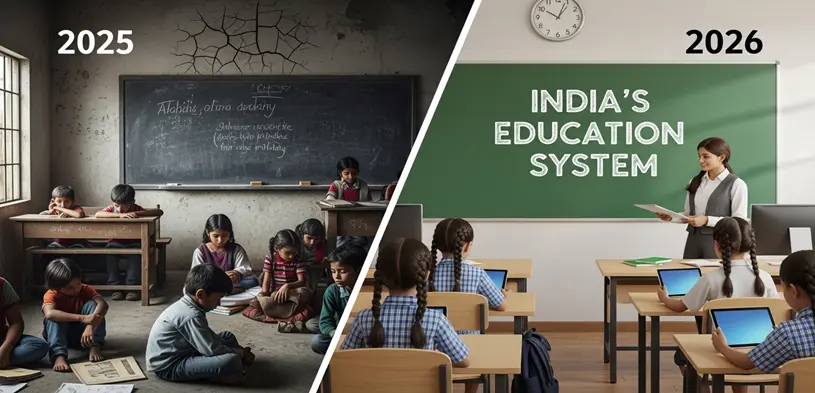Education is often hailed as the great equalizer, a powerful tool that can lift individuals out of poverty and pave the way for a brighter future. In India, a nation of over 1.4 billion people, this promise holds immense potential, yet for millions of poor and needy children, access to quality education remains a distant dream.
As of 2025, alarming statistics reveal the depth of this crisis: around 56% of 10-year-olds in India cannot read basic text, a phenomenon known as learning poverty. This issue disproportionately affects low-income families, where economic hardships, inadequate infrastructure, and social barriers combine to create insurmountable obstacles. Enrollment has dipped by over 1 crore in 2023-24, with 47.44 million out-of-school children (OOSC) nationwide, including 1.1 million officially reported.
This blog dives deep into the harsh realities of the Indian education system for poor children in 2025, exposes the systemic failures, highlights government and NGO efforts to bridge the gap, and showcases real success stories that prove change is possible. Looking ahead to 2026, we’ll explore emerging policies and budgets that could turn the tide—if implemented effectively.
The Harsh Reality: Why Poor Children Are Left Behind in 2025
The Indian education system, despite progress, continues to fail its poorest citizens. Poverty forces families to choose between food and schooling. In rural India, children as young as 8 drop out to work in fields, factories, or homes, with at least 35 million aged 6-14 out of school.
Government schools—often the only option for low-income families—suffer from crumbling infrastructure: no clean water, broken toilets, no electricity, and absent teachers. In remote villages, children walk miles to reach a school that may not even have a blackboard. Gender adds another layer of discrimination. Girls from poor households are pulled out earlier due to safety concerns, early marriage, or household duties, forming nearly half of OOSC. Post-COVID, chronic absenteeism has surged, with millions never returning to classrooms.
The digital divide widened the gap—while urban students shifted to online learning, rural poor children had no access to devices or internet. Even when enrolled, the quality of education is abysmal: rote learning, overcrowded classrooms (60–100 students per teacher), and irrelevant curricula prepare no one for real-world success. After three years at school, over 25% of children still cannot read, and 50% struggle with basic arithmetic.
The result? A vicious cycle. Uneducated children become low-wage laborers, trapping generations in poverty. The system isn’t broken—it’s built this way for the privileged, and the poor pay the price. Heading into 2026, UNESCO warns India is off-track by 75 million students for national targets, with conflict zones and data gaps underestimating the crisis.
Government Schemes: Promises vs. Ground Reality in 2025
India has launched ambitious programs to make education free and inclusive, but execution lags far behind intent.
- Right to Education (RTE) Act, 2009: Mandates free education for ages 6–14 and reserves 25% of seats in private schools for economically weaker sections (EWS). Yet, many private schools reject EWS students or demand hidden fees.
- Sarva Shiksha Abhiyan (SSA): Aims to universalize elementary education. It has built schools, but teacher absenteeism and poor training undermine the impact.
- Mid-Day Meal Scheme: Feeds over 120 million children daily. It boosts attendance but suffers from corruption, poor hygiene, and persistent malnutrition.
- Kasturba Gandhi Balika Vidyalaya (KGBV): Residential schools for girls from marginalized communities. Effective where functional, but many remain understaffed.
- Samagra Shiksha Abhiyan: Integrates school education from pre-primary to Class 12. Focuses on equity, but funds are unevenly distributed.
Despite these, millions remain out of school. Bureaucracy, corruption, and lack of awareness mean schemes don’t reach the neediest. Enrollment has risen to 96% in some areas due to mid-day meals, but learning outcomes have collapsed. In 2025, campaigns like Jharkhand’s Ruar-2025 enrolled 59,000 OOSC, but high-risk states like Uttar Pradesh (784,000 OOSC) lag.
NGOs Filling the Void: Real Change on the Ground
Where the system fails, NGOs step in with innovation, dedication, and results. A standout example is Narayan Seva Sansthan’s Narayan Children Academy, a completely free English-medium school in Udaipur that educates over 550 underprivileged children from LKG to Class VII.
It provides quality state-board education with digital classrooms, daily nutritious meals, free uniforms and stationery, safe bus transport from remote villages, and on-site healthcare—ensuring no child drops out due to poverty or hunger. Through international teacher training partnerships, it delivers holistic development, turning vulnerable kids into confident learners ready to break the cycle of poverty.
In 2025, the academy continues to expand its reach, with plans for enhanced STEM integration in 2026 to align with national skill pushes.
Spotlight: Narayan Seva Sansthan’s Free Narayan Children Academy
One shining example is Narayan Seva Sansthan, a Udaipur-based NGO that runs the Narayan Children Academy—a 100% free English-medium school for underprivileged children from LKG to Class VII.
Established in 2015 by Prashant Agarwal, the academy currently educates over 550 students (1,834+ since inception) from economically and socially marginalized families. Here’s what they provide completely free:
✅ Quality Education: State board syllabus with digital classrooms
✅ Nutritious Lunch: Daily meals to fight hunger and boost focus
✅ Uniforms & Stationery: No cost to parents
✅ Free Bus Service: Safe transport from remote villages
✅ Healthcare: On-site medical checkups and support
✅ Teacher Training: Partnerships with Georgia Southern University (USA) for STEM education
This isn’t charity—it’s systemic empowerment. Children who once begged or labored now dream of becoming doctors, engineers, and teachers. As NEP evolves in 2026, the academy is poised to incorporate vocational modules, amplifying its impact.
The Way Forward: What India Must Do in 2025 – And Bold Steps for 2026
To fix the system, India needs urgent action in 2025: Fix implementation by ending corruption in schemes and using tech for transparent fund tracking. Invest in teachers by training, paying, and retaining quality educators in rural areas. Close the digital divide by providing tablets and internet in government schools.
Make private schools accountable by enforcing RTE’s 25% EWS quota with penalties. Boost community awareness through door-to-door campaigns about free education rights. And scale public-private-NGO partnerships, like expanding Narayan Children Academy models nationwide.
The National Education Policy (NEP) 2020 promises holistic, equitable education—but only if funded and executed. In 2025, NEP marks five years with milestones like over 12,000 PM SHRI schools upgraded and NIPUN Bharat pushing foundational literacy by 2026-27. States like Goa roll out NEP for Grades 6 and 10 in 2025-26, emphasizing the 5+3+3+4 structure.
Looking to 2026, the Union Budget 2025-26 allocates ₹1.05 lakh crore (~$12.6 billion) to education—a 6.22% increase—with ₹78,572 crore for school education (up 16.3%). Key initiatives include ₹500 crore for an AI Centre of Excellence in Education for personalized learning, ₹2,000 crore for the IndiaAI Mission, and expansion of smart classrooms to 50% of government schools.
Vocational training becomes mandatory in secondary schools by 2027-28, with NCERT revising textbooks for competency-based learning by 2026. The National Digital University launches in January 2026, aiming for 100% GER in school education by 2030. If realized, these could slash learning poverty to under 40% and enroll 75 million more students—but success hinges on equitable rollout to the rural poor.
Final Word: Every Child Deserves a Fair Shot
India’s education system isn’t failing poor children by accident—it’s failing them by design. But 2025 shows hope: enrollment is up, gender gaps are narrowing, and NGOs like Narayan Seva Sansthan are proving that free, quality, holistic education works. As 2026 unfolds with AI-driven reforms and boosted budgets, the question evolves: from can we educate every poor child?” to will we scale these wins nationwide?”
Because an educated child today is an empowered India tomorrow. Support initiatives like Narayan Children Academy—donate, volunteer, advocate. The future starts now.







